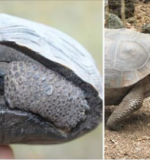It’s been more than a century since even a single baby tortoise was sighted on the Galapagos island of Pinzón.
The recent birth of these little shelled babies are a step in the right direction to help pull these beautiful, but critically endangered animals back from the edge of extinction, after years of human activity nearly laying the population to waste.
“I’m amazed that the tortoises gave us the opportunity to make up for our mistakes after so long,” says researcher James Gibbs who was among the first to see the hatchlings in December, told The Dodo.

In the mid 18th century when sailors first landed on the island, they unknowingly introduced foreign species such as rats.
The rats that snuck aboard those early ships and getting off on the island paradise decimated the population as they began eating tortoise eggs as one of their main sources of food.
As they had very few natural predators to keep their numbers down, Rats began multiplying and started eradicating the island’s tortoise population.
Things got so bad, in fact, that not a single tortoise offspring was able to survive the disaster decades long after the rats were first introduced.
This environmental catastrophe has taken generations to correct.
But now that we’ve seen the mistake that previous humans have created for this majestic animal, these humans have been able to help save them.

In the 1960s, conservationists were able to launch a collaborative effort to save the species with only 100 tortoises remaining at the time.
The scoured the island to find the last few remaining unhatched eggs they could find and incubated them on another island.
They were hatched and raised on that island for around five years, roughly until they were big enough to not be attacked by the rats before they were introduced back to the island, although rodents still devoured any eggs that were remaining on the island.
It wasn’t until 2012 that biologist were able to develop and distribute a poison using helicopters that was designed to only attract rats.
“The incredible eradication of rats on this island, done by the park service and others, has created the opportunity for the tortoises to breed for the first time,” says Gibbs.

“We did a survey [in December] to see if it was working for the tortoises, and we found 10 new hatchlings. This is the first time they’ve bred in the wild in more than a century.”
And while 10 might not seem like a the biggest baby boom, Gibbs says it’s just the tip of the iceberg:
“Given projection probabilities, I’m sure there were a hundred times more hatchlings out there.”
In all, Gibbs and his team spotted 300 tortoises on their trip, and suggests that there are now more than 500 estimated to be currently living on the island.
My faith in humanity has been restored!
Great job team!
If you enjoyed this story, and you are happy to see the tortoise population come back please share it with your friends and family on facebook!







 Photographer Finds Locations Of 1960s Postcards To See How They Look Today, And The Difference Is Unbelievable
Photographer Finds Locations Of 1960s Postcards To See How They Look Today, And The Difference Is Unbelievable  Hij zet 3 IKEA kastjes tegen elkaar aan en maakt dit voor zijn vrouw…Wat een gaaf resultaat!!
Hij zet 3 IKEA kastjes tegen elkaar aan en maakt dit voor zijn vrouw…Wat een gaaf resultaat!!  Scientists Discover 512-Year-Old Shark, Which Would Be The Oldest Living Vertebrate On The Planet
Scientists Discover 512-Year-Old Shark, Which Would Be The Oldest Living Vertebrate On The Planet  Hus til salg er kun 22 kvadratmeter – men vent til du ser det indvendigt
Hus til salg er kun 22 kvadratmeter – men vent til du ser det indvendigt  Nearly Frozen Waves Captured On Camera By Nantucket Photographer
Nearly Frozen Waves Captured On Camera By Nantucket Photographer  Superknepet – så blir snuskiga ugnsformen som ny igen!
Superknepet – så blir snuskiga ugnsformen som ny igen!  It’s Official: Astronomers Have Discovered another Earth
It’s Official: Astronomers Have Discovered another Earth  Meteorite That Recently Fell in Somalia Turns Out to Contain Two Minerals Never Before Seen on Earth
Meteorite That Recently Fell in Somalia Turns Out to Contain Two Minerals Never Before Seen on Earth 
hc5zc5
uo82wv
mxss02
vu0c3j